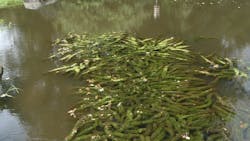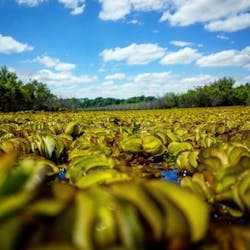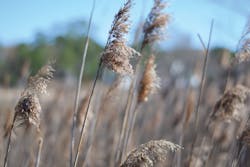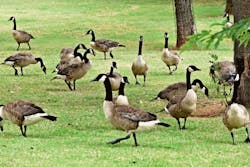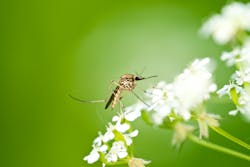Mastering vegetation management for stormwater and watershed areas requires extensive knowledge of the surrounding environment and great attention to detail. With many varying factors such as climate, environmental changes and soil types, vegetation treatment plans may change and should be re-evaluated on a consistent basis.
Maintaining a strong understanding of the physical, chemical and natural makeup of the surrounding environment is the first step to proper and safe vegetation management around stormwater and watershed locations. Understanding pest infestations is another important part of vegetation management. Vegetation buildup not only impacts the water quality and shoreline structure but also attracts a variety of pests, which can introduce additional health and safety risks.
To better evaluate aquatic vegetation and pest management needs, stormwater and watershed managers should remember to assess, anticipate and assemble. These steps will help preserve the water and habitat and protect the people and employees who are served by the surrounding waterways.
Assess Invasive Plants
It’s important for water managers to understand which types of invasive plants may be prone to their water sources. Assess the invasive plant to better understand how it spreads and the risks involved in order to identify the proper treatment plan.
Ean Sims, Aquatic Biologist at SOLitude Lake Management Solutions, a sister company of Rentokil North America, identified three common types of invasive aquatic vegetation.
Submerged Weeds
Submerged weeds are rooted deep into the waterbody floor and can quietly spread under the surface level if left unattended. Unmanaged submerged weeds can clog water intake systems, create flooding risks and disturb the natural predator-prey relationships in an aquatc ecosystem. Common types of submerged vegetation include:
Floating Weeds
Floating weeds have a vascular underwater root system, yet their roots are not typically attached to sediment allowing them to “float” to the top. Floating weeds can be extremely invasive and can quickly spread across the water’s surface level. These plants can also drift into nearby waterways making them a threat to the surrounding area. Common types of floating weeds include:
- Water Hyacinth
- Water Lettuce
- Giant Salvinia
- Water Chestnut
Emergent plants can be tricky as they typically only grow in shallow water, but they can expand up onto the shoreline. Standing upright in shallow water they have complex root systems and, if left unchecked, they can take over and destroy thousands of acres of wetlands. Not only can these plants cause harm to water sources but they are also a threat to the wildlife and surrounding landscape. Common emergent plants include:
- Water Primrose
- Torpedograss
- Alligator Weed
- Smartweed
Anticipate Pests
When dealing with invasive vegetation, be sure to watch for pest harborages. Pests and plants are nature’s perfect companions. Overgrown vegetation is often the home for many pests such as birds and insects. If left untreated, pest infestations can quickly lead to contaminated water, shoreline destruction and many other costly problems. Two common water-loving pests that watershed managers should anticipate include:
Birds
Birds seek out vegetation for food, shelter and nesting, and many aquatic birds are particularly drawn to vegetation around water sources. Birds can transmit more than 60 different types of diseases, introduce parasites, damage property and contaminate the air. Common water-prone bird species include:
- Mud Swallows: These federally protected birds seek out mud surrounding water sources to build their nests.
- Seagulls: Although this protected species prefers nesting at higher elevations, they feed off of fish, crustaceans and other water sourced creatures.
- Canada Geese: These federally protected birds build their nests on water shorelines and feed off of submerged vegetation. They can live up to 30 days without food and carry a number of diseases and bacteria in their fecal matter.
Mosquitos
During the day, mosquitoes spend their time resting on low-lying vegetation. The higher humidity levels of the vegetation and water sources allow them to survive daytime temperatures without drying out. While they seek shelter during the day, they come out in force between dusk and dawn. Mosquitos carry a variety of harmful diseases so it’s extremely important to be on the lookout for these blood-sucking insects. When dealing with mosquitos, use the process of defend, dress and drain:
- Defend: Use an EPA approved insect repellent according to label directions. Repellents should contain: DEET, picaridin, or oil of lemon eucalyptus and IR3535.
- Dress: Wear long sleeves, long pants and socks when near water or heavily wooded areas, especially during peak mosquito activity hours. Spray insect repellent on bare skin as well as on clothing to ensure proper protection.
- Drain: Ensure waterways are free flowing. Drain or treat areas that may be prone to puddling as mosquitoes can breed in as little as a bottlecap of water.
Assemble a Treatment Plan
When determining the right treatment plan, stormwater and watershed managers need to consider a variety of factors. Water quality, environmental factors and sediment types are just a few variables to consider. The ultimate goal for vegetation management should always be to preserve and protect the ecosystems, habitats and communities served by that area.
Work with trusted professionals who will take the time to get to know and understand the unique characteristics of the area being treated. Only use environmentally responsible and sustainable treatments that will not cause additional harm to the ecosystem. Water managers should also consider a multi-tier treatment plan, as pests can become immune to solutions and the natural habitat may shift over time. SW
Roger Dickens is the technical services manager for Vegetation Management & Wildlife Control at Rentokil North America. He has worked for Rentokil for more than 16 years.
Published in Stormwater magazine, August 2021.
About the Author
Roger Dickens
Roger Dickens is the technical services manager for Vegetation Management & Wildlife Control at Rentokil North America. He has worked for Rentokil for more than 16 years.
